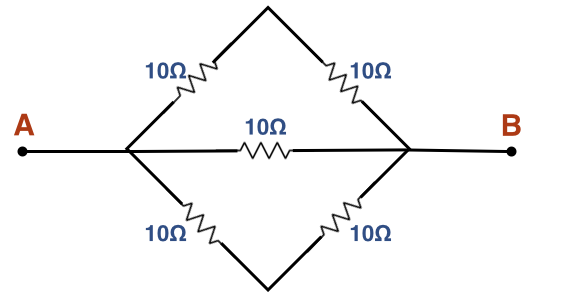A Square of Resistors
Find the equivalent resistance between the points A and B . All of the Resistors are of 1 0 Ω .

The answer is 5.
This section requires Javascript.
You are seeing this because something didn't load right. We suggest you, (a) try
refreshing the page, (b) enabling javascript if it is disabled on your browser and,
finally, (c)
loading the
non-javascript version of this page
. We're sorry about the hassle.
2 solutions
I got 0.2 Ohms, idk why: 0.05 + 0.1 + 0.05 = 0.2 Ohms, im right?, lol, 3deep5me this problem.
Hey brother don't you think there is a Wheatstone bridge forming. So I believe the answer is 10, please correct me if I am wrong
Log in to reply
Well can you explain your steps?
Log in to reply
Dude I got the answer right but we know there is a Wheatstone Bridge only if A/B=C/D. If you have HC Verma 2, check in the chapter Electric Current in conductors, (page 181)
Log in to reply
@Department 8 – the wheatstone bridge is totally different .. the terminals of the resistors for which the supposed resistor with no current is not directly attached but attached between the combination
Log in to reply
@Jaswinder Singh – Thanks for that explanation!+1! ⌣ ¨
@Jaswinder Singh – Oh! Never knew of that thanks.
This is wrong weet stone bridge mid resistor will not work and=10 will be the answer
Why it is not wheat stone bridge. Give me concrete reason
Log in to reply
Ok, wait see the following figure:

In this case, there is a Wheatstone bridge and the current won't flow through R 3 (assuming that this is a balanced bridge). I hope you get it.
Because we are not in the context of a wheatstone bridge. It is a simple case of resistors in parallel. It is drawn to resemble the wheatstone bridge, and likely tricked those who did not observe it carefully.
Log in to reply
Thanks sir, and if you were the person who changed the image, thanks again! ⌣ ¨
Must see to that the figure given satisfies the condition of WHEAT STONE BRIDGE. hence the current wont pass through the mid resistor. and the upper and lower give resistance of 20 ohms each and that too in parallel and this gives the equivalent resistance as 10.
Log in to reply
Sorry, but it does not form a Wheatstone bridge, it just appears so.
Log in to reply
plz can u explain me the reason for that?
Log in to reply
@A Former Brilliant Member – It is just a question to trick us. Those who observe it very very carefully, get wrong answers. It is just a case where resistors are parallel to each other
@A Former Brilliant Member – Ok, wait see the following figure:

In this case, there is a Wheatstone bridge and the current won't flow through R 3 (assuming that this is a balanced bridge). I hope you get it.
Log in to reply
@Sravanth C. – ok thnk u. i got it
Log in to reply
@A Former Brilliant Member – Thanks okay, hope you enjoyed the problem! ⌣ ¨
In this it is WHEATSTONE NETWORK current would not flow through 20 phm resistor
The resistor symbols in this circuit indicate that they are all short circuited; Therefore answer should technically be 0.
This is a very simple circuit. In particular, it is not the Wheatsone bridge (see note below). We can easily observe the the circuit can be collapsed into a 1 0 Ω resistor in parallel with two 2 0 Ω resistors as shown in the figure below:
Thus the equivalent resistance will be: R e q 1 = 2 0 1 + 1 0 1 + 2 0 1 = 2 0 1 + 2 + 1 = 5 1 ∴ R e q = 5 Ω
Note: For those who think that this is the Wheatstone bridge, look at the image carefully. The Wheatstone bridge connects the other 2 set of vertices, like so: